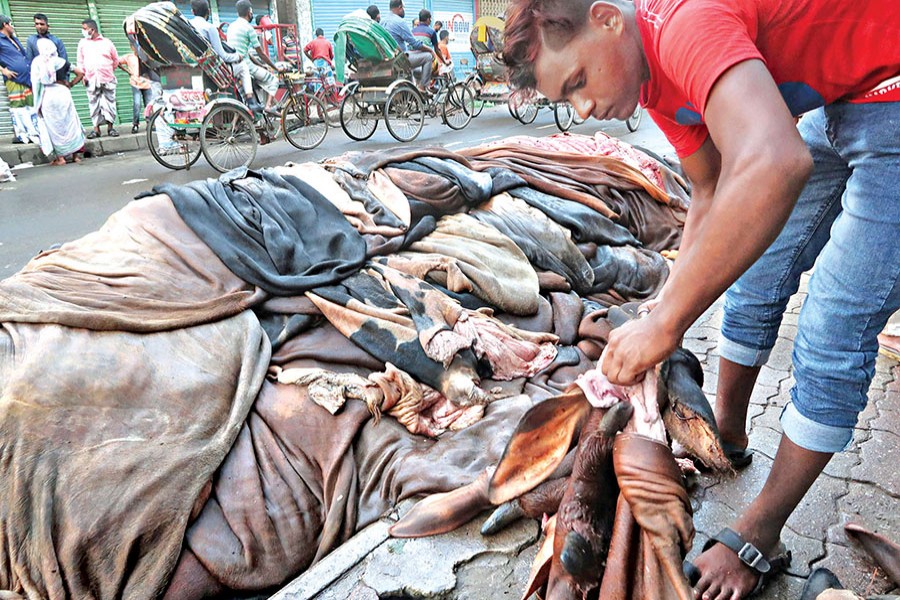 A seasonal trader sorting out rawhides of sacrificial cattle on a roadside at Nawabpur in the city on Saturday, the day of Eid-ul-Azha — FE photo
A seasonal trader sorting out rawhides of sacrificial cattle on a roadside at Nawabpur in the city on Saturday, the day of Eid-ul-Azha — FE photo The government's recent decision on exporting rawhides has little impact over domestic sourcing as skins of sacrificial animals are selling lower than the official rate, traders say.
The situation forced seasonal traders to incur substantial losses and many went back home with gloomy faces.
Protesting the poor rate, traders in some places were reported to have thrown the valuable raw materials of the leather goods into the river and roads like previous years.
Expecting good business thanks to the export decision, seasonal traders collected the rawhides from various parts of the country and brought those to the city's Posta, New Market and Science Lab areas for sales.
But their hopes for handsome profits vanished into thin air soon after arriving in the selling points where they found the rates significantly lower than the official rate.
Considering the global market trend and the pandemic, the government slashed the price of each square foot of cow rawhide to Tk 35-40 in Dhaka. It was Tk 45-50 last year.
Elsewhere, the rate was fixed between Tk 28 and Tk 32 per square foot for rawhide of cow. It was Tk 35-40 last year.
Terming the rate lowest in recent times, seasonal traders said it caused huge financial losses to them like the last year.
Al-Amin Hossain, who carried with him six rawhides at Science Lab, said he sold those at Tk 3,000, although he purchased those at Tk 4200.
"Forget about profit, I could not even get the purchasing price. I incurred a huge loss last year too," he said on a note of frustration.
Like many others, he collected rawhides expecting to make some profits this year with an eye to the decision on exports.
"But the situation remains unchanged," he said.
Md Farid Uddin, a seasonal hide trader at Rayer Bazar in the city, said the prices of hide increased slightly at Posta, but still much lower.
"I sold 11 bull hides of medium to big size at Tk 600-850 per piece today, almost at the price I purchased," he said.
He said goat skin has no price this year at all. He collected 150 goat skins from the caretakers of many houses at Rayer Nazar and Mohammadpur at free of cost but yet to get any customer for the skin.
"If I don't get any buyer for skins in one or two days, I might have nothing to do but to throw those into nearby water bodies," he said.
Aftab Khan, president of the Bangladesh Hide and Skin Merchant Association, defended the rate, saying the price at which raw leather is selling is right.
It costs Tk 7.0- Tk 9.0 to process per square foot of leather, including expenditure for salt and labourers.
Apart from that, the aratdars (big traders) are in cash shortage as most of the tanners have yet to pay their last year's arrears, he said.
Sakhawat Ullah, general-secretary of the Bangladesh Tanners Association, said though the number of sacrificial animals was fewer in the pandemic, prices are also low due to the fall in demand both at home and abroad.
He said tanners have yet to use their full capacity amid the slow progress in the Savar Tannery Estate.
But he predicted prices of the raw leather will go up in the next few weeks as big traders started preserving hides for making profits.
He admitted that small seasonal traders would not be able to make their desired profits.
Mr Ullah said tanners are also afraid of getting back their investments amid sluggish business due to the pandemic.
About the wastage of rawhides, president of the Bangladesh Tanners Association Shahin Ahmed said less than 1.0 per cent of the rawhide goes to waste because of the poor processing by seasonal merchants.
Research director of Centre for Policy Dialogue Dr Khondaker Golam Moazzem said considering the past price debacle, the government formed several committees to monitor the trading and their activities were not visible during and after Eid.
He said the government's decision on the exports of rawhides and wet-blue leather is a welcoming one but it should have taken such a decision much earlier.
"The export decision was taken a few days before Eid. So the tanners and traders do not get enough time to get prepared," he said.
The economist, however, laid emphasis on bringing transparency in the supply chain system, saying that rawhides are often traded without cash payment, which does not exist in the global supply chain.
According to the Department of Livestock Services (DLS), nearly 4.5 million cows and 5.5 to 6.0 million goats and sheep were sacrificed during the Eid-ul-Azha festival.
But the number of sacrifices declined by 20 per cent compared with the previous year due to the pandemic, said DLS.
© 2024 - All Rights with The Financial Express
